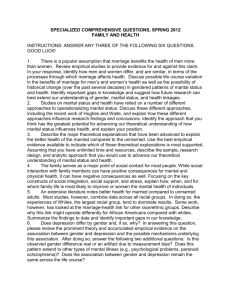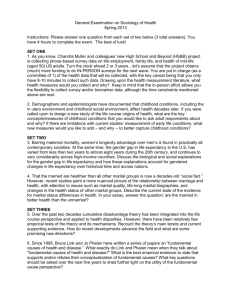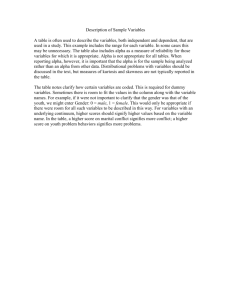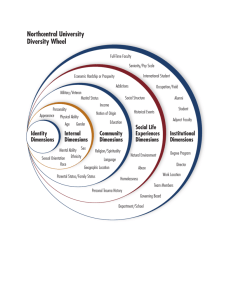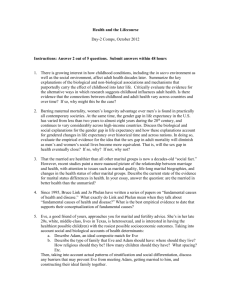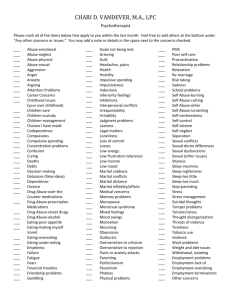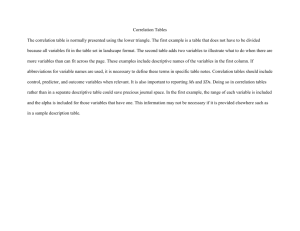Principles of Effective Writing for research
advertisement
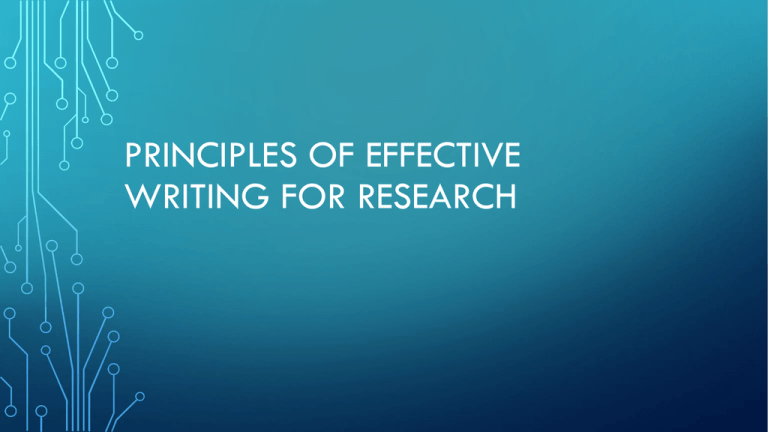
PRINCIPLES OF EFFECTIVE WRITING FOR RESEARCH FIVE STEPS IN WRITING A LITERATURE REVIEW • Coming up with a good idea. • Gathering relevant research, review, and theoretical articles. • Creating an outline of the paper • Writing the first draft • Revising and polishing the manuscript WHAT IS A GOOD RESEARCH IDEA? • “Any good research question should be able to pass the “so what” test; the answer to the question should be important, interesting, and meaningful” (Kwiatkowskie & Silverman, 1998, 1114). • Idea has to pass the “so what?” test. • MFTs need to care about the question. • It is important • MFT’s are interested in the question • Answer to the question will have an impact on the field. • A good question to ask is “How many MFTs will be interested in the question?” OTHER ELEMENTS OF GOOD IDEA • The research question needs to be original. • • • However, not all novel research ideas are good ones. • • • It needs to produce new information Replication of an existing study, though, can sometimes be a good research idea in order to make the results more robust and stronger. “Gap-spotting” refers to researchers who have identified a gap in the literature without make an argument that the gap is important and meaningful. A good research idea is often linked to a theory or basic assumption. A good research idea is interesting to the researcher THREE ELEMENTS OF WRITING RESEARCH ARTICLES • Contextualization • Show how the study fits within the existing literature, in general, and related studies, specifically. • Description • Describe what you did in your study. • Give enough detail so that the study could be replicated. • Justification • Provide rationale for the decisions you made in your methods. INTRODUCTION • Convey the overall rationale and objective of the study. • Three purposes • Show that your research question is important and significant (So what?) • Typically focus on the dependent variable • Can link it to a theory • Show that your research question hasn’t already been answered by other researchers (show a gap in the literature) • Often use words like, “however”, “although”, “despite” to begin argument that there is gap • State the purpose of the study • The introduction is mainly about contextualization • It should be about a page and a half. WRITING A RESEARCH MANUSCRIPT IS LIKE WRITING A NOVEL; IT MUST HAVE A CLEAR STORYLINE. STICK TO THE STORYLINE AND MAKE IT CLEAR THROUGHOUT THE MANUSCRIPT. JUST LIKE A NOVEL, YOU ADD DESCRIPTION, SETTING, AND DETAILS (E.G. CONTEXTUALIZATION AND METHODS) TO MAKE THE STORY CREDIBLE. BUT MAKE SURE THE STORYLINE IS ALWAYS CLEAR. LITERATURE REVIEW • The introduction is like the opening statement in a trial where the attorney lays out the main arguments in general terms. The lit review is like the main part of the trial where the evidence is presented in more detail. • • Literature review is also mainly contextualizing What do you include in the lit review? • • • • Not everything! (There are page limits) Just review literature and sections that are important to your storyline Literature review should be viewed as consisting of building blocks (e.g. sections) Sections are determined by your dependent and independent variables and the relationship you are going to test. MODEL ADDRESSING THE RELATIONSHIP BETWEEN MARITAL CONFLICT, DEPRESSION, AND HEALTH ELEMENTS OF THE LIT REVIEW FOR PROCEEDING MODEL • Relationship between marital conflict and health • Add theory as appropriate • Relationship between marital conflict and depression • Relationship between depression and health • Studies that have looked at depression as a mediating variable between marital conflict and health. • These studies would be the springboard studies, where you need to go into more detail and show how your study is going to fill an important gap. • “Close the deal” by summarizing the lit review and introducing your formal hypotheses. CLOSING THE DEAL “With only limited evidence that marital distress is associated with physical health problems among Chinese married couples, it is important to more fully examine this relationship. Moreover, the role of depression as a mediating variable between marital distress and health problems has yet to be explored within the Chinese culture. Based on research conducted in the U.S., as well as preliminary research conducted in China and Taiwan, the following hypotheses were tested:” WRITING A LIT REVIEW IS A SYNTHESIS OF STUDIES, NOT A LIST OF THEM. • The goal of a lit review is to provide a synthesis of the existing literature. • This is done by providing topic sentences for each paragraph, rather than simply describing one or two studies in each paragraph. • Provide a topic sentence that makes a statement (“Research has generally found a positive relationship between the therapeutic alliance and therapy outcome.”) • THEN provide support from studies to support your statement. A SYNTHESIZING LIT REVIEW PARAGRAPH There is some evidence that marital quality is associated with life satisfaction and personal well-being among Chinese couples. A series of studies by D. T. L. Shek using samples in Hong Kong have found an association between marital quality and personal well-being. In 1995, he sampled 1,499 men and women to study the impact of marital quality on well-being among Chinese married adults (Shek, 1995). He found that marital quality was significantly associated with personal well-being. In another study that used longitudinal data, Shek (2000) studied 378 Chinese families and found that marital quality predicted personal well-being, life satisfaction, and health two years later. Although these studies provide evidence that marital quality is a significant predictor of personal well-being, they did not specifically measure depressive symptoms. NOT ALL RESEARCH STUDIES ARE CREATED EQUAL FOUNDATIONAL STUDIES “There is substantial empirical evidence that marital distress is a significant risk factor for physical health problems. Research using large, nationally representative data sets has consistently found a negative association between marital distress and global measures of self reported health (Bookwala, 2005; Hawkins & Booth, 2005; Ren, 1997; Ryff, Singer, Wing, & Love, 2001; Umberson, Williams, Powers, Liu, & Needham, 2006; Whisman & Uebelacker, 2006).” SPRINGBOARD STUDIES “Two previous studies have used growth curve analysis on three-wave panel data to examine the influence of marital quality on physical health. Wickrama et al. (1997) analyzed data from 356 husbands and wives living in the rural Midwest. Using a measure of health that assessed self-reported physical symptoms and diseases, they found that marital quality had a significant impact on physical illness over a 3year span, after controlling for initial levels of physical illness, education, income, and work-related stress.” SPRINGBOARD STUDIES (CONT.) “In the second study, Umberson et al. (2006) analyzed three waves of panel data, spanning 8 years, from the Americans’ Changing Lives survey. They examined the association between marital quality and physical health among 1,049 continuously married people who ranged in age from 24 to 96. They analyzed negative and positive marital interaction separately and found that positive marital interaction was associated with self reported global health at the beginning of the survey, but positive marital interaction was not related to subsequent change in health over the eight years of the study. On the other hand, negative marital interaction was significantly associated with both initial levels of health and subsequent changes in health.” WRITING STYLE • Scientific writing is precise and efficient. • • “Omit needless words” Don’t write with a flowery style • Stay consistent in use of key words (e.g. just use marital quality, not marital satisfaction, marital adjustment, marital quality, and marital functioning) • • Master APA style Don’t use meta-comments (e.g. “I will now describe the three theories that explain the relationship between marital conflict and health.” ) METHODS SECTION • The methods section is mainly descriptive, with some justification needed to provide rationale for decisions made. • Elements of methods section • Procedures • • • • • • Sample frame and how sample was obtained How data were collected—procedures used; final sample size and response rate Sample characteristics (basic demographic information) Measurement Analytic strategy Biggest and most common mistake is not providing enough details in your description of the methods TYPICAL METHODS SECTION OUTLINE • Sample • Procedure • Measures • Dependent variable • Independent variable(s) • Control variables • Analysis RESULTS SECTION • Just the facts—don’t editorialize; save that for the discussion section • Give preliminary results first (means, zero order correlations) • Present results of main hypotheses • Use tables and figures to help tell the story more clearly • Must use tables and figures sparingly AGAIN, USE TOPIC SENTENCES “Results of the gender analyses indicated that the effect of both spouses’ marital satisfaction on their own depressive symptoms did not differ significantly. The Chi-Square difference between the unconstrained model and the model where actor effects were constrained to be equal was .93 (df 1, p .33), indicating that there was no difference in the path coefficients between wives’ marital satisfaction and their own depressive symptoms and husbands’ marital satisfaction and their own depressive symptoms. Constraining the partner effects to be equal resulted in a Chi-Square difference between the two models that approached significance (2 3.72, df 1, p .053) but did not meet the standard of statistical significance at the .05 level.” DISCUSSION SECTION • Brief summary of the findings • Contextualize the findings by placing them back into the larger literature • Need to “make sense” of your findings. • If your hypotheses were supported, this is easy because you have already made the case in the literature review. Link your finding back to what you talked about in your lit review. • “These findings are consistent with previous research that has examined the relationship between marital quality and health (Bookwala, 2005; Hawkins & Booth, 2005). • If hypotheses were not supported, you need to make sense of the findings and present arguments why these findings are plausible based on existing research literature. • • • • This often takes some work and requires the use of references Limitations Directions of future research Clinical implications (if submitted to a clinical journal) ABSTRACT “Although there is substantial evidence that low marital satisfaction is a significant risk factor for depression, little research has examined this relationship in cultures outside of the U.S. and Europe. The validity of the marital discord model of depression in Chinese culture was tested by studying 391 couples living in Beijing and Hangzhou, China. Results of structural equation modeling using an actor–partner interdependence model strategy indicated that husbands’ and wives’ marital satisfaction was significantly predictive of their own depressive symptoms. In addition, wives’ marital satisfaction significantly predicted husbands’ depressive symptoms. These results provide evidence that the marital discord model of depression is useful in understanding the role of marital dissatisfaction as a risk factor for depressive symptoms in collectivistic societies, such as China.” ELEMENTS OF THE ABSTRACT • • • • • • • • 100-150 words Include research purpose/question Include brief justification Include sample and sample size Include type of analysis Include brief statement of results Include brief statement of implications/conclusion Write it after finishing the paper HOW TO BE A PRODUCTIVE WRITER • Have a very well developed outline of the intro and lit review BEFORE starting to write your first draft. • Include references to the articles that you will use in each section. • Having a good outline is probably the most important aspect of having a well organized lit review. It also makes the writing process much faster and less tedious (and painful). • Follow the outline when writing your first draft. • Use sentences/phrases from your outline as topic sentences • In your first draft, don’t “self-edit”. • Do revisions AFTER you have written the first draft. JUST WRITE! • Write every day!
